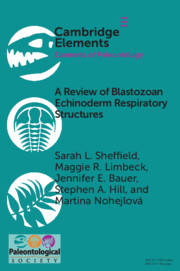Refine search
Actions for selected content:
53 results
Chapter 25 - Organizational Settings of Respiratory Care throughout the World: A Bird’s-Eye View and Sample
-
-
- Book:
- Clinical Neurorespiratory Medicine
- Published online:
- 26 May 2025
- Print publication:
- 19 June 2025, pp 323-333
-
- Chapter
- Export citation
Chapter 5 - The Respiratory Muscle Pump and Respiratory Mechanics
-
-
- Book:
- Clinical Neurorespiratory Medicine
- Published online:
- 26 May 2025
- Print publication:
- 19 June 2025, pp 41-49
-
- Chapter
- Export citation
Chapter 8 - Neurorespiratory Diagnostics
-
-
- Book:
- Clinical Neurorespiratory Medicine
- Published online:
- 26 May 2025
- Print publication:
- 19 June 2025, pp 71-79
-
- Chapter
- Export citation
Chapter 28 - Respiratory System: Anatomy
-
-
- Book:
- BASIC Essentials
- Published online:
- 21 February 2025
- Print publication:
- 13 March 2025, pp 154-157
-
- Chapter
- Export citation
Chapter 41 - Principles of Paediatric Intensive Care
-
-
- Book:
- Core Topics in Paediatric Anaesthesia
- Published online:
- 06 February 2025
- Print publication:
- 13 February 2025, pp 467-479
-
- Chapter
- Export citation
Chapter 41 - Travel-Related Infections
- from Section 3 - Clinical Syndromes
-
- Book:
- Clinical and Diagnostic Virology
- Published online:
- 11 April 2024
- Print publication:
- 18 April 2024, pp 197-199
-
- Chapter
- Export citation
Chapter 54 - Antiviral Drugs
- from Section 5 - Patient Management
-
- Book:
- Clinical and Diagnostic Virology
- Published online:
- 11 April 2024
- Print publication:
- 18 April 2024, pp 263-273
-
- Chapter
- Export citation
Chapter 56 - Infection Control
- from Section 5 - Patient Management
-
- Book:
- Clinical and Diagnostic Virology
- Published online:
- 11 April 2024
- Print publication:
- 18 April 2024, pp 282-285
-
- Chapter
- Export citation
Chapter 40 - Respiratory Virus Infections
- from Section 3 - Clinical Syndromes
-
- Book:
- Clinical and Diagnostic Virology
- Published online:
- 11 April 2024
- Print publication:
- 18 April 2024, pp 192-196
-
- Chapter
- Export citation
Chapter 65 - Malignant Pleural Effusion
- from Section 7 - Respiratory System
-
- Book:
- Pocket Guide to Oncologic Emergencies
- Published online:
- 10 August 2023
- Print publication:
- 24 August 2023, pp 277-280
-
- Chapter
- Export citation
Chapter 63 - Laryngectomy Complications
- from Section 7 - Respiratory System
-
- Book:
- Pocket Guide to Oncologic Emergencies
- Published online:
- 10 August 2023
- Print publication:
- 24 August 2023, pp 269-272
-
- Chapter
- Export citation
Chapter 66 - Tracheostomy Complications
- from Section 7 - Respiratory System
-
- Book:
- Pocket Guide to Oncologic Emergencies
- Published online:
- 10 August 2023
- Print publication:
- 24 August 2023, pp 281-284
-
- Chapter
- Export citation
Chapter 64 - Malignant Central Airway Obstruction
- from Section 7 - Respiratory System
-
- Book:
- Pocket Guide to Oncologic Emergencies
- Published online:
- 10 August 2023
- Print publication:
- 24 August 2023, pp 273-276
-
- Chapter
- Export citation
Chapter 60 - Cancer Treatment Induced Interstitial Lung Disease
- from Section 7 - Respiratory System
-
- Book:
- Pocket Guide to Oncologic Emergencies
- Published online:
- 10 August 2023
- Print publication:
- 24 August 2023, pp 259-262
-
- Chapter
- Export citation
Chapter 61 - Hemoptysis
- from Section 7 - Respiratory System
-
- Book:
- Pocket Guide to Oncologic Emergencies
- Published online:
- 10 August 2023
- Print publication:
- 24 August 2023, pp 263-266
-
- Chapter
- Export citation
Chapter 62 - Hiccups
- from Section 7 - Respiratory System
-
- Book:
- Pocket Guide to Oncologic Emergencies
- Published online:
- 10 August 2023
- Print publication:
- 24 August 2023, pp 267-268
-
- Chapter
- Export citation
Section 7 - Respiratory System
- from Part 3 - Systems Based Overview of Cancer Complications
-
- Book:
- Pocket Guide to Oncologic Emergencies
- Published online:
- 10 August 2023
- Print publication:
- 24 August 2023, pp 259-259
-
- Chapter
- Export citation

A Review of Blastozoan Echinoderm Respiratory Structures
-
- Published online:
- 16 December 2022
- Print publication:
- 26 January 2023
-
- Element
- Export citation
Chapter 20 - Anaesthetic Breathing Systems
-
-
- Book:
- Fundamentals of Operating Department Practice
- Published online:
- 18 August 2022
- Print publication:
- 08 September 2022, pp 218-223
-
- Chapter
- Export citation
Obesity and loss of ambulation are associated with lower extremity oedema in Duchenne muscular dystrophy
-
- Journal:
- Cardiology in the Young / Volume 33 / Issue 4 / April 2023
- Published online by Cambridge University Press:
- 13 May 2022, pp. 597-602
-
- Article
- Export citation
